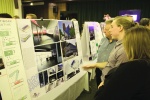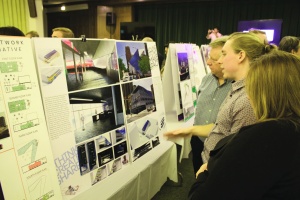By Justin Wier
In December, 75 Kent State University architecture students presented the results of their senior design studio at the Lewis School in Youngstown and they will be displayed again at the McDonough Museum of Art this summer.
As part of a year-long collaboration between Kent State’s College of Architecture and Environmental Design and Youngstown State University’s Regional Economic Development Initiative, the students designed buildings for Youngstown’s downtown.
Dominic Marchionda, city-university planner for the Regional Economic Development Initiative, helped coordinate the students’ efforts. He said he was impressed by how the students turned their research into physical designs.
“You saw 75 students take that work and really hone in on the built environment,” Marchionda said.
He said he was also impressed by the environmental focus of many of the designs.
“Youngstown’s always got that perception of a steel town … with smoke clouding our skyline and settling over all the buildings,” Marchionda said. “So it was really cool to see them be cognizant of the environment and how it affects the river.”
John McNally, mayor of Youngstown, checked in with students during the process and spoke at the event.
“I’m amazed by the transformation of a lot of these projects,” McNally said.
In accordance with the city’s development goals, students focused on around 30 sites along the Hazel and Phelps Street corridors between the University and the riverfront.
“Everything they did was, ‘How are we connecting campus to the downtown to the riverfront?’” Marchionda said.
Each student designed a new construction project and a renovation of an existing building ranging from grocery stores to skate parks. One project proposed an aquarium research center along the riverfront that could serve as an educational tool and lab for local students.
Mike Hripko, YSU’s associate vice president of research, is focused on implementation.
“We’ve got the ideas. We’ve got the plan. And now we’ve got to put it into action,” Hripko said.
In the last year, the Regional Economic Development Initiative has unveiled a Downtown Vision and Action Plan, presented the results of a design charrette carried out by the Cleveland Urban Design Collaborative and released a citywide economic development strategic plan.
Marchionda said he has been matching grant opportunities with initiatives in the plan, and linking those to design work that was done by the Kent students and the Cleveland Urban Design Collaborative.
“We can show them here’s how you go get this done,” Marchionda said. “We’re going to break that down for you, so you can actually go take a chunk out of it and work the plan until it’s something tangible that you can touch.”
Marchionda is working with Leslie Brothers at the McDonough to develop a way of displaying the initiatives and designs for the public.
The exhibit could feature virtual reality, posters and presentations, voice recordings and videos.
“We want it to serve as an exhibit of all this great work that’s happened over this last year as a result of the Kent collaboration and in the past with local partners,” Marchionda said. “But we also want to use it [to tell a story] and a month-long community feedback session.”
He said it’s important to get feedback from the community because if the citizens don’t care about implementing these ideas and designs, they aren’t going to go anywhere.
“[All across history] you see these revered men and women in rooms discussing grandiose ideas, this is that venue you see in paintings. This is reality. This is Youngstown. This is right here on Wick Avenue in one of our art galleries,” Marchionda said.

